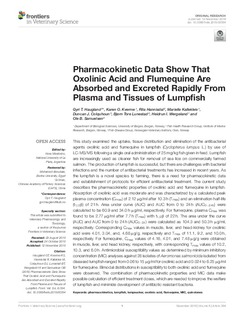| dc.description.abstract | This study examined the uptake, tissue distribution and elimination of the antibacterial agents oxolinic acid and flumequine in lumpfish (Cyclopterus lumpus L.) by use of LC-MS/MS following a single oral administration of 25 mg/kg fish given in feed. Lumpfish are increasingly used as cleaner fish for removal of sea lice on commercially farmed salmon. The production of lumpfish is successful, but there are challenges with bacterial infections and the number of antibacterial treatments has increased in recent years. As the lumpfish is a novel species to farming, there is a need for pharmacokinetic data and establishment of protocols for efficient antibacterial treatment. The current study describes the pharmacokinetic properties of oxolinic acid and flumequine in lumpfish. Absorption of oxolinic acid was moderate and was characterized by a calculated peak plasma concentration (Cmax) of 2.12 μg/ml after 10.3 h (Tmax) and an elimination half-life (t1/2β) of 21 h. Area under curve (AUC) and AUC from 0 to 24 h (AUC0−24h) were calculated to be 60.9 and 34.0 h μg/ml, respectively. For flumequine, plasma Cmax was found to be 2.77 μg/ml after 7.7 h (Tmax) with t1/2β of 22 h. The area under the curve (AUC) and AUC from 0 to 24 h (AUC0−24) were calculated as 104.3 and 50.3 h μg/ml, respectively. Corresponding Cmax values in muscle, liver, and head-kidney for oxolinic acid were 4.01, 3.04, and, 4.68 μg/g, respectively and Tmax of 11.1, 9.2, and 10.0 h, respectively. For flumequine, Cmax values of 4.16, 4.01, and 7.48 μg/g were obtained in muscle, liver, and head kidney, respectively, with corresponding Tmax values of 10.2, 10.3, and 6.0 h. Antimicrobial susceptibility values as determined by minimum inhibitory concentration (MIC) analyses against 28 isolates of Aeromonas salmonicida isolated from diseased lumpfish ranged from 0.06 to 15 μg/ml for oxolinic acid and 0.024 to 6.25 μg/ml for flumequine. Bimodal distributions in susceptibility to both oxolinic acid and flumequine were observed. The combination of pharmacokinetic properties and MIC data make possible calculation of efficient treatment doses, which are needed to improve the welfare of lumpfish and minimize development of antibiotic resistant bacteria. | nb_NO |
